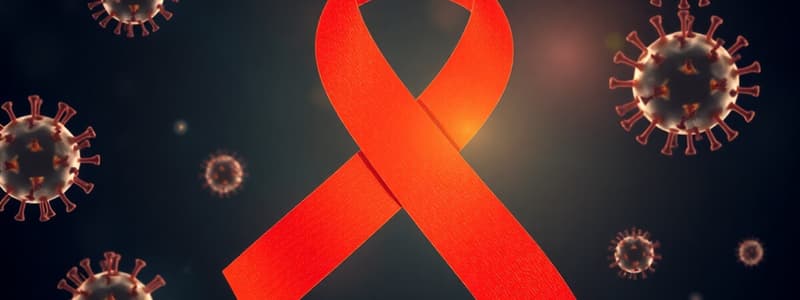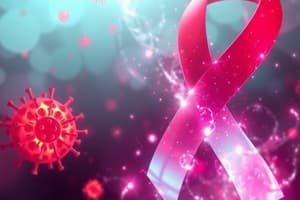Podcast
Questions and Answers
Why does HIV primarily target cells like macrophages and T-helper cells?
Why does HIV primarily target cells like macrophages and T-helper cells?
- These cells express CD4 molecules on their surface, which HIV uses for attachment. (correct)
- These cells lack the necessary defense mechanisms to prevent viral entry.
- These cells are the only ones present in the lymph nodes where HIV replicates.
- These cells actively engulf pathogens, inadvertently internalizing HIV.
How does the integration of proviral DNA into the host cell's genome affect the course of HIV infection?
How does the integration of proviral DNA into the host cell's genome affect the course of HIV infection?
- It allows the virus to remain dormant and replicate when the immune cell is activated. (correct)
- It allows the virus to be easily eliminated by the host's immune system.
- It immediately triggers cell death, preventing further viral replication.
- It enables the host cell to produce antibodies against HIV.
What is the role of reverse transcriptase in the HIV lifecycle, and why is it significant for treatment strategies?
What is the role of reverse transcriptase in the HIV lifecycle, and why is it significant for treatment strategies?
- It is responsible for integrating HIV DNA into the host cell genome, making the infection permanent.
- It destroys the host cell's DNA, creating space for viral replication.
- It translates viral RNA into proteins necessary for viral assembly.
- It converts viral RNA into DNA, which is essential for integration into the host cell. (correct)
During the acute phase of HIV infection, what immunological event primarily contributes to the initial control of viral replication?
During the acute phase of HIV infection, what immunological event primarily contributes to the initial control of viral replication?
How do the X4 and R5 strains of HIV differ in terms of cellular tropism and disease progression?
How do the X4 and R5 strains of HIV differ in terms of cellular tropism and disease progression?
What distinguishes between the chronic phase of HIV infection and the progression to AIDS?
What distinguishes between the chronic phase of HIV infection and the progression to AIDS?
Why are individuals with homozygous genetic mutations in CCR5 resistant or immune to HIV infection?
Why are individuals with homozygous genetic mutations in CCR5 resistant or immune to HIV infection?
Which of the following HIV diagnostic tests is typically used as the initial screening test, and what does it detect?
Which of the following HIV diagnostic tests is typically used as the initial screening test, and what does it detect?
How does antiretroviral therapy (ART) primarily benefit individuals infected with HIV?
How does antiretroviral therapy (ART) primarily benefit individuals infected with HIV?
Besides sexual intercourse and intravenous drug use, what is another significant route of HIV transmission?
Besides sexual intercourse and intravenous drug use, what is another significant route of HIV transmission?
Flashcards
AIDS
AIDS
A syndrome caused by HIV that leads to immunodeficiency, increasing the risk of infections and tumors.
HIV
HIV
A virus that targets cells in the immune system, leading to immunodeficiency.
gp120
gp120
The main protein HIV uses to attach to CD4 molecules on immune cells.
HIV
HIV
Signup and view all the flashcards
Viral Tropism
Viral Tropism
Signup and view all the flashcards
Acute HIV Infection
Acute HIV Infection
Signup and view all the flashcards
Antiretroviral Therapy (ART)
Antiretroviral Therapy (ART)
Signup and view all the flashcards
Progression from HIV to AIDS.
Progression from HIV to AIDS.
Signup and view all the flashcards
RNA/DNA tests
RNA/DNA tests
Signup and view all the flashcards
Antibody tests
Antibody tests
Signup and view all the flashcards
Study Notes
Overview of HIV and AIDS
- HIV (Human Immunodeficiency Virus) primarily targets cells in the immune system, particularly CD4+ T-helper cells, which play a vital role in orchestrating the body's immune response. The infection of these cells results in immunodeficiency, severely compromising the body’s capacity to defend itself against various infections and diseases that would otherwise be managed effectively. Without adequate CD4+ T cells, the immune response is diminished, making individuals vulnerable to opportunistic infections and certain cancers.
- Immunodeficiency increases the risk of infections and tumors, as the body can no longer effectively control pathogens that it would normally fend off. Such conditions create a fertile ground for the development of a range of diseases that exploit the weakened state of the immune system.
- Complications arising from a failed immune system due to the progression of HIV infection are collectively referred to as AIDS (Acquired Immunodeficiency Syndrome). AIDS is characterized by a significantly reduced CD4+ cell count and the occurrence of opportunistic infections or specific cancers that are rare in people with a healthy immune system.
- HIV-1 is the most prevalent strain of the virus and is primarily associated with the AIDS epidemic worldwide, including in the United States. Its widespread nature means it poses a major public health challenge.
- HIV-2 is a less common variant of the virus and is mainly found in geographical regions such as western Africa and southern Asia. While it generally progresses to AIDS more slowly than HIV-1, it is still a cause for concern in affected populations.
HIV's Target: CD4+ Cells
- HIV specifically targets CD4+ cells, which are characterized by the presence of CD4 molecules on their membranes. This interaction is crucial as it initiates the viral entry process.
- Key immune cells such as macrophages, T-helper cells, and dendritic cells possess CD4 molecules, rendering them susceptible to HIV infection. This targeting is instrumental in the virus's ability to disrupt normal immune function.
- The CD4 molecule serves a fundamental role in facilitating the attachment and communication between immune cells, particularly during encounters with pathogens. As the virus hijacks these cells, it undermines immune signaling pathways, hampering the body's defense mechanisms.
- HIV employs a glycoprotein known as gp120 to bind to the CD4 molecule effectively. This binding is a critical step in the viral entry process, enabling the virus to later attach to a co-receptor necessary for cell entry.
- In addition to gp120's role, it is important for HIV to bind to a co-receptor, which is necessary for the virus to facilitate its entry into the host cell. This dual binding is vital for the fusion of the viral envelope with the host cell membrane.
- Common co-receptors that HIV utilizes include CXCR4, predominantly found on T-cells, and CCR5, which is present on T-cells, macrophages, monocytes, and dendritic cells. The reliance on these co-receptors is crucial for HIV's infection lifecycle.
- Some individuals possess homozygous genetic mutations in the CCR5 co-receptor, providing them with a natural resistance or immunity to HIV infection. This genetic trait significantly reduces their risk of becoming infected with the virus.
- Individuals with heterozygous mutations (having one normal and one mutated gene) may still have a reduced risk of infection or can experience a slower progression of the disease, highlighting the role of genetic factors in HIV susceptibility.
- The virus gains entry into the host cell by binding to the CD4 molecule and either CCR5 or CXCR4, launching the process that leads to viral replication within the infected cell.
HIV as a Retrovirus
- HIV is classified as a single-stranded, positive-sense, enveloped RNA retrovirus. This means that its genetic material is composed of RNA and it has a lipid envelope, which is derived from the host cell's membrane.
- The virus utilizes an enzyme known as reverse transcriptase to convert its RNA genome into proviral DNA. This enzyme is essential to the retroviral lifecycle, allowing HIV to integrate into the host's genetic material.
- Once reverse transcription occurs, the resulting proviral DNA incorporates itself into the host's DNA, establishing a permanent presence within the cell. This integration is critical as it allows the virus to evade the immune system and persist in a latent state.
- Upon activation of the immune cell, the integrated proviral DNA is inadvertently transcribed and translated into new viral proteins, ultimately leading to the assembly of new HIV particles.
- Newly formed viruses bud off from the cell membrane, allowing them to infect adjacent cells and perpetuate the cycle of infection. This process contributes to the gradual depletion of CD4+ cells.
- HIV has a high mutation rate due to the error-prone nature of reverse transcriptase during replication, leading to the emergence of diverse viral strains. This genetic variability contributes to challenges in treatment and vaccine development.
- Viral tropism refers to the specific preference that certain strains of HIV exhibit for infecting different types of host cells. For instance, some strains may predominantly infect T-cells, while others may target macrophages or dendritic cells, influencing the overall disease progression.
Stages of HIV Infection
- Early Stage: Acute infection
- HIV typically spreads through sexual intercourse and can also be transmitted through sharing contaminated needles or from mother to child during childbirth or breastfeeding.
- The R5 strain of HIV, which is the most common variant present at the initial stages of infection, binds with high affinity to the CCR5 co-receptor, thereby infecting macrophages, dendritic cells, and T cells.
- Dendritic cells, being key antigen-presenting cells, carry the virus to lymph nodes. This migration results in a more extensive dissemination of the infection throughout the body, leading to widespread viral replication within T-helper cells, macrophages, and other immune cells.
- During this acute infection phase, there is a pronounced spike in HIV replication accompanied by a peak viral load in the patient’s blood. This is the time when individuals are most infectious to others.
- Patients may experience nonspecific flu-like symptoms or mononucleosis-like symptoms, which can include fever, sore throat, fatigue, and swollen lymph nodes. These symptoms may mislead individuals into thinking they have a common viral illness rather than a serious infection.
- As the immune system recognizes the presence of the virus, it mounts a counterattack aimed at controlling HIV replication. This response can lead to transient declines in viral load as the body attempts to regain control.
- Following this initial immune response, HIV levels decline but typically remain detectable in the blood by approximately 12 weeks after infection, marking a phase of clinical latency where the virus continues to replicate at lower levels.
- The chronic or clinically-latent phase can last between 2 to 10 years, during which time the virus continues to reside in the body, although often without significant symptoms.
- In this chronic phase, T-cell counts roughly correlate with viral load levels, indicating the ongoing immune response to the virus.
- In the majority of cases, T-cell counts tend to remain above 500 cells/mm3, allowing patients to generally fend off other infections effectively. However, there can be an increase in the incidence and severity of diseases such as tuberculosis during this time.
- Amidst this chronic infection, some patients may transition to developing an X4 strain of HIV, which specifically targets the CXCR4 co-receptor primarily found on T-cells alone.
- X4 strains are particularly harmful as they lead to the destruction of CD4 T cells in lymphoid tissues, accelerating the decline in immune function.
- The T-cell counts will subsequently drop to between 200 and 500 cells/mm3, and patients may begin to present with symptoms such as persistent swollen lymph nodes or recurrent infections; however, they are still classified as having HIV during this stage.
- Once the T-cell count falls below 200 cells/mm3, patients progress from HIV to AIDS, marking a critical point in the infection trajectory.
- Individuals with AIDS often experience a constellation of debilitating symptoms including persistent fever, chronic fatigue, significant weight loss, and diarrhea, as the immune response continues to weaken.
- As the disease progresses, the HIV count in the blood can rise dramatically, suggesting increased viral replication and load.
- AIDS-defining conditions emerge during this advanced stage, leading to a range of opportunistic infections and malignancies such as recurrent bacterial pneumonia, pneumocystis pneumonia, various fungal infections, and certain cancers, which signify a critical need for medical intervention and treatment.
Transmission Routes
- Male-to-male transmission remains the most common mode of HIV transmission within the United States, often highlighted in statistical analyses of infection rates.
- In resource-limited settings, male-to-female transmission is frequently reported as the primary means of spreading HIV, influenced by socio-economic factors and access to healthcare services.
- Female-to-male transmissions occur less frequently, but they do happen. Understanding the dynamics of transmission is crucial for targeted prevention strategies.
- In fact, over 75% of HIV cases globally are contracted through sexual intercourse, underscoring the need for safe sex practices and education to reduce transmission rates.
- Other common ways that HIV can be transmitted include intravenous drug abuse through sharing contaminated needles and mother-to-child transmission, which can occur during pregnancy, delivery, or breastfeeding.
- Less common modes of transmission include accidental needlesticks in healthcare settings and transmission via blood products through blood transfusions, although strict screening processes have minimized these risks in most developed countries.
Diagnosis and Treatment
-
Various tests exist for diagnosing HIV, including antibody tests, antibody/antigen tests, and RNA/DNA tests, each serving a unique purpose in identifying the presence of the virus.
-
Antibody tests specifically detect the antibodies that the immune system produces in response to HIV infection. These tests are critical for screening but often take time to show positive results following exposure.
-
Antigen tests look for the virus directly in the blood, allowing for earlier detection compared to standard antibody tests.
-
RNA tests screen for the presence of viral RNA in the bloodstream, providing a direct indication of active viral replication, while DNA tests focus on detecting viral DNA copies, which can signal infection.
-
The antibody/antigen test has become the recommended screening tool due to its ability to detect both antibodies and antigens, increasing the likelihood of identifying the infection when it is still in the early stages.
-
If the primary screening test yields a positive result, a confirmatory test is necessary to verify the presence of antibodies or nucleic acids, ensuring the accuracy of the diagnosis.
-
Despite advancements in treatment, there is currently no known cure for AIDS, making early diagnosis and consistent management critical to improving patient outcomes.
-
Antiretroviral therapy (ART) has proven to be an effective intervention that can significantly improve the quality of life for patients with HIV, enabling them to live longer, healthier lives while also reducing the risk of transmission to partners.
-
ART comprises a combination of medications that work to slow down HIV replication within the body, thereby allowing the immune system a chance to recover and better combat other infections or illnesses that may arise.
-
By controlling the replication of HIV, ART not only helps maintain CD4+ T cell counts but also significantly reduces the likelihood of reaching AIDS, ultimately contributing to improved long-term health outcomes for individuals living with HIV.
-
t slows down HIV replication.
-
Slowing HIV replication allows the immune system to recover and fight off other infections.
Studying That Suits You
Use AI to generate personalized quizzes and flashcards to suit your learning preferences.




